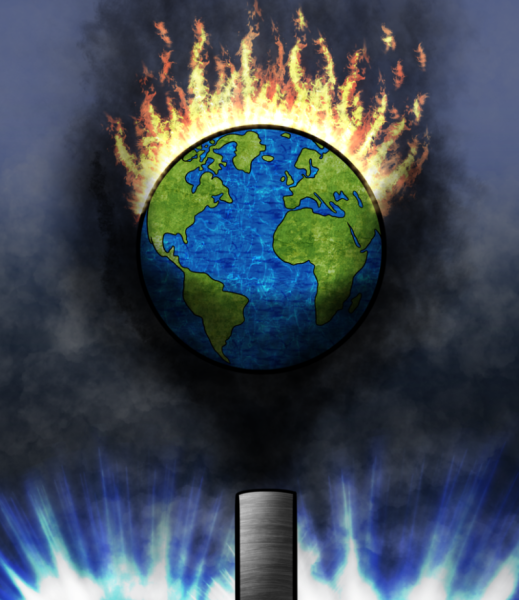
Illustration by Mia Eshima
Climate change and global warming have been terrible issues for the Earth for nearly as long as our generation can remember. In simple terms, the Earth has a fever; thankfully, like any fever, there are treatments humanity can put into effect.
One of the biggest causes of climate change is gas emissions from burning fossil fuels, which powers the economy but also contributes to temperature rises in the atmosphere. The use of fossil fuels has caused Earth to grow hotter and hotter every day.
Even in landfills, methane emissions are cemented underneath garbage, producing harmful emissions for potentially hundreds of years. Environmentalists are innovating a way to suction these gasses out of landfills through underground wells. These extractions would be converted into renewable natural gas and used as a source of energy.
Cars are a staple form of transportation for many people in cities. Every car besides electric vehicles pollutes some sort of emissions in the atmosphere; moreover, these emissions build up and form larger clouds of pollution. Investing in purchasing an EV is investing in the future of our Earth, our home. It helps to create a solution to our Earth’s growing fever and will significantly reduce the amount of emissions in the air at any given time.
The next step would be to improve upon our current roads, which had little to no innovation for years. Scientists have discussed making smart highways that cater to the growing use of electric vehicles. Being exposed to the sun all day, charging stations would power the highway tiles. When electric cars go over the road tiles it would send electricity to the receiving plate on the battery, charging the car on the go. This would create less traffic and congestion.
Inputting electric highways would lead to a plethora of benefits. The lack of sound from EVs would mean a cut down on sound pollution in local communities. These highways would not require any additional energy for street lights because of luminescent dynamic paint and could create an incentive for people to buy an EV. Solar charging stations would be housed on the right-of-way. All these changes would help our dirty infrastructures become clean.
Reducing atmosphere emissions is only part of the problem. Another issue to address is the use, misuse and overuse of energy. Some forms of energy come from the Earth itself, which do not cause harm if they are used; however, overuse of these resources can worsen the health of our planet. Other forms of energy are produced via the destruction and pollution of the Earth. Finding more environmentally sound and safe ways to produce or save energy is an investment in the future.
One on-the-rise way to reduce energy usage is by installing green roofs, appearing as small parks or gardens blanketing rooftops. Covering acres of rooftops, these “living roofs” contribute to air and water filtration, agriculture, irrigation and temperature regulation. They circulate water usage and the amount of energy needed to sustain a building.
Similarly, light-emitting diodes, or LEDs, significantly reduce power and energy loads in homes. They use about 90% less energy than conventional lighting, which can dramatically change how much emissions are being put out into the atmosphere.
As with LEDs, heat pumps are initially expensive but utilize less power and reduce harmful emissions in the long run. Heat pumps operate from one central unit, so they are easy to install and can be adapted to most buildings. They are also fifty percent more effective than traditional electric resistance heating.
Outside of our cities, there is also the issue at hand of natural forests being destroyed due to air pollution and its harmful emissions. In many countries with surrounding oceans, emissions have taken away so many natural resources due to kelp forests dying.
Environmentalists have determined that marine permaculture arrays, which were introduced by Director Brian Von Herzen of the Climate Foundation, can help regrow kelp forests. These arrays would circulate deep cold ocean water filled with nutrients to the surface to reduce heat and make a better ecosystem for kelp forests and marine life to grow.
According to the Climate Foundation, materials would cost $2.6 million per square mile, but there would be an economic return of $10 trillion. If a million MPAs were active for 30 years, it would reduce CO2 emissions by 102 billion tons. This would be a positive change to help Earth recover from its fever. By focusing on natural resources and taking care of our oceans, our atmosphere will gradually return to a neutral composition with little to no emissions.
There are many ways for us to treat our planet, with the named above being the larger means of impact. Smaller impacts include showering for shorter periods and recycling.
Every bit of effort helps, but the only way anything gives toward worthwhile change is if enough of us realize the necessity for change and the treatment of our world. If we all do our part, then a clean and healthy future for the world will soon be realized.

















































































